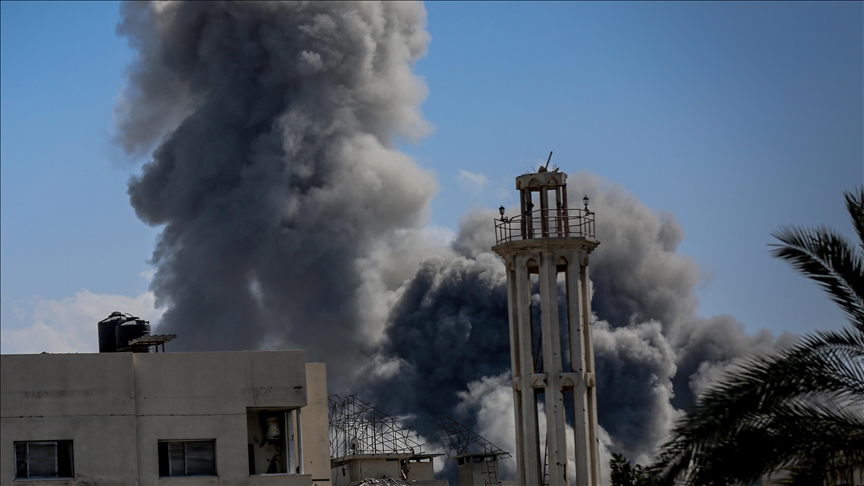2 years of genocide: How Gaza’s environment is collapsing under Israel’s assault
97.1% of tree crops damaged, while 61M tons of debris litter the enclave, says UN Environment Program

- 'You can't breathe,’ says environmental engineering expert, describing poor air quality
- Israel is succeeding in its goal of making Gaza unlivable, says head of Palestine Institute for Biodiversity and Sustainability
ISTANBUL
Israel’s genocidal war in Gaza, which has entered its third year, has not only claimed tens of thousands of lives but also unleashed an environmental disaster that experts say could take decades to undo.
A report released by the UN Environment Program (UNEP) last month found that by May 2025, 97.1% of Gaza’s tree crops, 82.4% of annual crops and 95.1% of shrubland had been destroyed. Soil contamination from munitions, solid waste and untreated sewage has made large-scale food production nearly impossible, it added.
Once fertile land is now blanketed in debris and toxins, groundwater is poisoned and the air is thick with smoke and contamination.
Experts warn that the environmental collapse amounts to a slow ecocide that may outlast the war and threaten Gaza’s future habitability.
Decades of land damage
While Israel’s current assault has intensified Gaza’s environmental destruction, experts say the degradation began long before.
“The colonization of Palestine has always been associated with an ecocide that started as early as the Zionist control in Palestine that was started actually in the 1920s,” Mazin Qumsiyeh, director at the Palestine Institute for Biodiversity and Sustainability of Bethlehem University, told Anadolu.
He traced the destruction back to the British Mandate era (1917–1948) and said it worsened after the 1948 Nakba, when more than 700,000 Palestinians were displaced and around 500 villages destroyed.
Native trees such as oaks, carobs and hawthorns, along with traditional crops like olives, figs and almonds, were systematically uprooted and replaced with imported pine trees, disrupting biodiversity and altering local ecosystems.
“More than 90% of tree cover in Gaza has been destroyed since October 2023 – but that does not mean this is a new phenomenon. Millions of Palestinian trees were uprooted before that,” Qumsiyeh said, recalling that more than 1.5 million trees were removed in the West Bank for the construction of Israel’s separation wall that began in 2002.
“The only thing that's different in the past two years is an acceleration of the genocide – the ecocide, the medicide, the scholasticide, destruction of everything that has to do with Palestinians, merely accelerated using the excuse of what happened on Oct. 7,” he added.
Lesley Joseph, research assistant professor of environmental engineering at the University of South Carolina, said farms that once provided food and livelihoods have been burned, bulldozed or rendered inaccessible, leaving soil barren and infertile.
“The actual diversity of that ecosystem is compromised,” he told Anadolu. “Now, the types of animals that rely on that grazing, any kind of birds, any kinds of aquatic life won't survive, and it won't come back.”
Land destruction not only disrupts biodiversity but also weakens ecosystems’ ability to protect the environment as a whole, Joseph said. For instance, he explained, trees and shrubs act as carbon sinks, absorbing greenhouse gases through their leaves and stems, helping to remove them from the air and purify the atmosphere.
Rebuilding Gaza’s agricultural base, he said, would take at least five to 10 years – and only if peace and freedom of movement are restored.
Aquifers depleted, sewage pollutes Mediterranean
The destruction of Gaza’s water systems has compounded the environmental crisis.
In its report, UNEP said the war has severely damaged Gaza’s water infrastructure, raising the risk of groundwater contamination and further reducing its already limited supply. Storage reservoirs and pumping facilities have suffered an 84% loss in capacity, with only nine of 54 still functioning as of April 2025. Of 214 desalination units, only 84 remain operational.
With piped systems destroyed and sanitation failing, wastewater is likely seeping into the aquifer and flowing into the Mediterranean, the report warned.
Qumsiyeh said Israel’s efforts to flood tunnels with seawater have further polluted groundwater.
“The water aquifer is no longer functioning … and may not even be repairable,” he said.
Both Joseph and Qumsiyeh warned that contamination now threatens everyone relying on shared water sources unless a large-scale cleanup begins soon.
Preventing fuel and electricity from entering Gaza has halted sewage treatment, allowing waste to flow directly into the sea and onto streets, Qumsiyeh said.
“Currently, there's no wastewater treatment. So, there's raw sewage being pumped or dumped into the Mediterranean Sea. That's going across the Gaza Strip, just streaming down the street because nobody's treating it. There's no way to treat it, no way to collect it,” Joseph said.
‘Smell of death’ lingers in Gaza’s air
By May 2025, Gaza authorities estimated that Israel had dropped 100,000 tons of explosives on the enclave.
Though comprehensive data on air quality are scarce, experts warn that bombings, fires and debris are releasing greenhouse gases and toxic chemicals that threaten health and ecosystems.
“You can't breathe,” Joseph said. “People living there describe it as the smell of death.”
He and other experts expressed alarm at the scale of debris – much of it contaminated with hazardous materials.
UNEP estimates that more than 61 million tons of debris now litter Gaza – 20 times the combined total from all previous conflicts since 2008. It will require extensive clearing, sorting, recycling or disposal.
“Where is that going to go? Who's going to clean it up? We don't have trash cans big enough to put that stuff in. There aren't landfills big enough to house it,” Joseph said.
Can recovery happen?
A joint World Bank, UN and EU assessment in February estimated that rebuilding Gaza would cost $53.2 billion over the next decade – including $1.9 billion for environmental recovery and $2.7 billion for water, energy and sanitation.
“You can work your way towards recovering. There's always a way to recover. I don't want anybody to think that there's no going back,” Joseph said
However, he said, it will take a lot of money, people, time and a whole lot of political will.”
Qumsiyeh said what would be needed for recovery remains uncertain.
“No studies are available or allowed to be done here anyway – Israel doesn't allow any,” he said. “They destroyed the local research capacity, they destroyed the universities and they destroyed the laboratories.”
He emphasized that rebuilding Gaza’s environment will require long-term commitment and international investment.
“Israel declared that they wanted to make Gaza unlivable,” Qumsiyeh said. “And they are succeeding.”
Anadolu Agency website contains only a portion of the news stories offered to subscribers in the AA News Broadcasting System (HAS), and in summarized form. Please contact us for subscription options.







